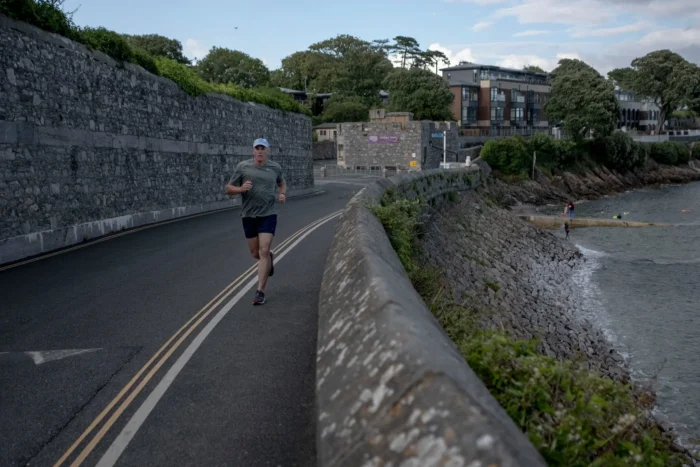
Erika Ayers Badan: What Do You Want?
Please meet Cynthia Pong. She came to me by way of super-connector and personal board director an occasional SVU actor, Sarah Storm. Cynthia Pong packs…
Thought Leader: Erika Ayers Badan

During its 315-mile journey from the Adirondacks to New York City, the Hudson River ranges from meek creek to mighty byway, flows past ghost towns, bombed-out factories and the state capital, and vacillates between stretches of pristine beauty and fetid intrusions of chemicals, bacteria and other toxic backwash.
And it is into that unpredictable mix that the British endurance athlete Lewis Pugh intends to dive next month, wearing nothing more than a Speedo, cap and goggles, with the intention of swimming the length of the Hudson — a monthlong plunge meant to draw attention to both the river’s continuing rescue and the work still to be done, here and elsewhere.
“I’ve been looking for a river for many, many years which could tell the story about all rivers,” said Mr. Pugh, 53, whose previous long-distance swims have included the length of the English Channel, some 325 miles. “And always, every single time, it comes back to the Hudson.”
Part of that, Mr. Pugh explains, is the Hudson’s unique endpoint in New York City, home to both rafts of reporters and the United Nations, where he serves as a so-called Patron of the Oceans, lobbying for clean seas.
“It shows how a river can be misused and then cared for and turn around its fate,” Mr. Pugh said in an interview from his home in Plymouth, England. “And so it gives hope to people who live on the Ganges, the people who live on the Yangtze, the Nile, the Seine or here in England on the River Thames. That your river can be saved.”
Such hopeful sentiments, of course, don’t belie the actual dangers — epidemiological and otherwise — that Mr. Pugh expects to encounter along the way: According to a medical guide prepared for the swim, he will be confronted by possible infection from everything from “human sewage and rat infestation” to poisoning from chemicals like mercury left over from the Hudson’s industrial past.
The Hudson also has a tide to consider, as well as other obstacles, including logs and branches, rocks and rapids, all of which can cause cuts, bruises or broken bones.
“Your swim can be over on Day 1,” Mr. Pugh said.
And that’s just in the water. Because the river often runs shallow in its upper stretches, Mr. Pugh will sometimes run on paths alongside it, where he is warned he could encounter all manner of terrestrial threats, including mosquitoes, disease-ridden ticks and venomous snakes. (If bitten, the medical guide warns, “Don’t try to catch the snake.”) Steep terrain, mud and swampy marshes beckon.
Even before he begins his swim on Aug. 13, Mr. Pugh will have to hike to the source of the Hudson: the remote and elegantly named Lake Tear of the Clouds, a glorified pond on the southern side of Mount Marcy, the state’s highest peak, just south of Lake Placid, N.Y.
He will not be the first to make the trip. In 2004, a fellow environmentally minded swimmer — Christopher Swain — swam from the headwaters to the harbor, albeit in a wet suit. But Mr. Pugh claims an additional challenge, saying he will swim “unassisted,” something his team defines as only using the aforementioned Speedo, goggles and cap — no gloves, flippers or mechanized assistance — and will be continually on the move, making progress downstream every day.
Unassisted, however, does not mean unaccompanied: Mr. Pugh’s team for the watery ramble will include a half-dozen or so support staff, including a cook, a physiotherapist and a “safety kayaker” who will paddle alongside Mr. Pugh when the water is deep enough to steadily swim. His swim, sponsored by a European asset management company, is scheduled to end at Battery Park on Sept. 13, in time to celebrate the signing of the High Seas Treaty at the U.N. — a historic agreement to protect ocean biodiversity — a week later.
His goal, he said, is that all rivers be “drinkable, fishable and swimmable,” noting that their waters end up in the sea.
“You can kill rivers,” he said. “We need to start respecting them.”
The Hudson’s degradation was specific to both New York’s industrial growth — it was abused by companies making paint, paper, batteries and other goods — as well as a part of a worldwide phenomenon, said David L. Strayer, a freshwater ecologist with the Cary Institute of Ecosystem Studies.
“Rivers have been used intensively for many purposes, and they’re valuable for many purposes, and historically all the uses weren’t carefully thought out or coordinated with one another,” Mr. Strayer said. “Somebody would dump slaughterhouse waste into a river, and they weren’t thinking about the guy who was swimming downstream or getting drinking water.”
For years, swimming in the Hudson was widely considered hazardous to your health, a trend that was reversed in no small part by the signing of the Clean Water Act of 1972, according to Dan Shapley, the senior director of advocacy, policy and planning program at Riverkeeper, an environmental nonprofit that monitors water quality and safe swimming spots.
“Fifty years ago, this kind of swim would have been much less imaginable,” Mr. Shapley said, noting that “we were dumping raw sewage from just about every community, everywhere.”
And while some communities, particularly near Albany and New York City, still feed sewage into the Hudson during rains, he said, “most of the river is safe for swimming most of the time,” so long as one keeps an eye out for boats, dangerous currents and unpredictable weather.
Both the state and the city health departments advise that bathers swim at regulated beaches, which are monitored for dangerous bacteria and other contaminants, with officials posting regular updates. New York City’s harbor is still “not considered a swimmable portion of the river,” according to the state environmental officials, but up the Hudson, open swims — ranging from polar dips to full-blown triathlons — abound.
Still, Mr. Shapley added that this summer’s violent downpours have caused wide swaths of the river to be considered unsafe on occasion, as sewers have overflowed and other contaminants have run off into the Hudson, including animal waste, street garbage and bird guano. (Interestingly, one famed pollutant — PCBs, or polychlorinated biphenyls, which made the Hudson the nation’s biggest Superfund site — are less of a concern for swimmers, as they usually collect in mud and on the bottom of the river.)
“In 36 years of swimming, I’ve only done four river swims because on three of them, I got seriously, seriously sick,” he said, recalling a terrible experience running into a patch of polluted water in the Thames. “I remember getting out the river and vomiting, and my teeth were actually wobbling in the gums.”
To that end, Mr. Pugh’s medical advice includes pre- and post-swim Pepto-Bismol, daily mouthwash for bleeding gums and frequent showers with antimicrobial skin cleanser.
He plans to swim about five hours a day, hoping to average 10 miles, while stopping to rest, meet locals and do interviews. “It is easier to swim to the media than to get the media to come to you,” he said. “It’s much more challenging if you’re at the North Pole.”
He’s training in Plymouth, swimming alongside ferry boats and running six or so miles a day. And last year, he came to New York to scout his route, making his way to Lake Tear of the Clouds, high in the Adirondacks, and taking a dip, an experience he said cemented his determination to swim downstream.
“I did a bit of backstroke and there was a turkey vulture just right above me,” he said. “The water’s fresh, you can just put your head in the water and just gulp away. And I thought, ‘This is what all rivers should be like.’”
Erika Ayers Badan: What Do You Want?
Please meet Cynthia Pong. She came to me by way of super-connector and personal board director an occasional SVU actor, Sarah Storm. Cynthia Pong packs…
Thought Leader: Erika Ayers Badan
Patrick McGee: Foreign Affairs Best Books of 2025
McGee, a Financial Times journalist, brings his investigative skills to bear on the fascinating history of how, over a quarter century, China and the technology…
Thought Leader: Patrick McGee
Dr. Sanjay Gupta: How to Identify Medical Misinformation
As a practicing neurosurgeon and CNN’s chief medical correspondent, Dr. Sanjay Gupta can spot false health claims from a mile away. Still, he recently became…
Thought Leader: Sanjay Gupta

